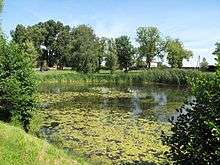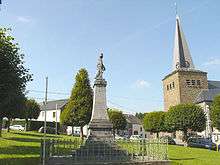Village green

A village green is a common open area within a village or other settlement. Traditionally, a village green was often common grassland at the centre of an agricultural or other rural settlement, and was used for grazing. Some also have a pond, often originally for watering stock such as cattle.
The village green also provided, and may still provide, an open-air meeting place for the local people, which may be used for public celebrations such as May Day festivities.
The term village green evokes a grassy rural environment. However the term is used more broadly to encompass woodland, moorland, sports grounds, and even—in part—buildings and roads. The green may also be positioned away from the centre of the village, especially if the village has moved, or been absorbed into a larger settlement.
Distribution

Some historical village greens have been lost as a result of the agricultural revolution and urban development. Greens are now most likely to be found in the older villages of mainland Europe, the United Kingdom, and older areas of the United States. Town expansion in the mid-20th century led in England to the formation of local conservation societies, often centring on village green preservation, as celebrated and parodied in The Kinks' album The Kinks Are The Village Green Preservation Society. The Open Spaces Society is a present-day UK national campaigning body which continues this movement.
The term can also apply to urban parks. In the United States, the most famous example of a town green is probably the New Haven Green in New Haven, Connecticut. New Haven was founded by settlers from England and was the first planned city in the United States. Originally used for grazing livestock, the Green dates from the 1630s and is well preserved today despite lying at the heart of the city centre. The largest green in the U.S. is a mile in length, and can be found in Lebanon, Connecticut. One of the most unusual is the Dartmouth Green in Hanover, New Hampshire, which was owned and cleared by the college in 1770. The college, not the town, still owns it and surrounded it with buildings as a sort of collegiate quadrangle in the 1930s, although its origin as a town green remains apparent.
A fine example of a traditional American town green exists in downtown Morristown, NJ. The Morristown Green dates from 1715 and has hosted events ranging from executions to clothing drives.
Town and village greens

.jpg)
Apart from the general use of the term, village green has a specific legal meaning in England and Wales, and also includes the less common term town green. Town and village greens were defined in the Commons Registration Act 1965, as amended by the Countryside and Rights of Way Act 2000, as land:
- which has been allotted by or under any Act for the exercise or recreation of the inhabitants of any locality
- or on which the inhabitants of any locality have a customary right to indulge in lawful sports and pastimes
- or if it is land on which for not fewer than twenty years a significant number of the inhabitants of any locality, or of any neighbourhood within a locality, have indulged in lawful sports and pastimes as of right.
Registered greens are now governed by the Commons Act 2006, but the fundamental test of whether land is a town and village green remains the same. Thus land can become a village green if it has been used for twenty years without force, secrecy or request (nec vi, nec clam, nec precario).[1] Village green legislation is often used to try to frustrate development. Recent case law (Oxfordshire County Council vs Oxford City Council and Robinson)[2] makes it clear that registration as a green would render any development which prevented continuing use of the green as a criminal activity under the Inclosure Act 1857 and the Commons Act 1876. This leads to some most curious areas being claimed as village greens, sometimes with success. Recent examples include a bandstand,[3] two lakes[4] and a beach.[5]
The Open Spaces Society states that in 2005 there were about 3,650 registered greens in England covering 8,150 acres (3,298 ha) and about 220 in Wales covering about 620 acres (251 ha).
Examples


A notable example of a village green is that in the village of Finchingfield in Essex, England, which is said to be "the most photographed village in England". The green dominates the village, and slopes down to a duck pond, and is occasionally flooded after heavy rain. The small village of Car Colston in Nottinghamshire, England, has two village greens, totaling 29 acres (12 ha).[6]
Some greens that used to be a common or otherwise at the centre of a village have been swallowed up by a city growing around them. Sometimes they become a city park or a square, and manage to maintain a sense of place. London has several of these: Newington Green, originally a Dissenting village, is one good example, with its church anchoring its north end.
There are two places in the United States called Village Green: Village Green-Green Ridge, Pennsylvania, and Village Green, New York. Some New England towns, along with some areas settled by New Englanders such as the townships in the Connecticut Western Reserve, refer to their town square as a village green. The only village green in the United States still used for agriculture lies in Lebanon, Connecticut. This green is also one of the largest in the nation.
In Indonesia, especially in Java, a similar place is called Alun-Alun. It is a central part of Javanese village architecture and culture.
The northern part of the province of Drenthe in the Netherlands is also known for its village greens. Zuidlaren is the village with the largest number of village greens in the Netherlands.
The Błonia Park, originally established in the Middle Ages, is an example of a large village green in Kraków, Poland.
See also
References
- ↑ For a discussion of the law on this, see Austen-Baker, R. and Mayfield, B.,"Uncommon Confusion: Parallel Jurisprudence in Town and Village Green Applications" [2012] Conveyancer 55.
- ↑ "Oxfordshire County Council v. Oxford City Council & Ors (2005) and others [2006] UKHL 25 (24 May 2006)". Bailii.org. Retrieved 14 September 2009.
- ↑ http://www.iwight.com/council/committees/Human%20Resources%20and%20Misc%20Appeals/1-9-06/Paper%20B.htm
- ↑ "Llyn Maelog lake on Anglesey given village green status". BBC News. 7 July 2011. Retrieved 7 July 2011.
- ↑ [2013] EWCA Civ 276
- ↑ Good Pub Guide Retrieved 2 April 2016.
External links
- The Open Spaces Society—gives UK information on how to claim a village green.
- Town Greens of Connecticut—historical information on the town greens that are found in almost every Connecticut town